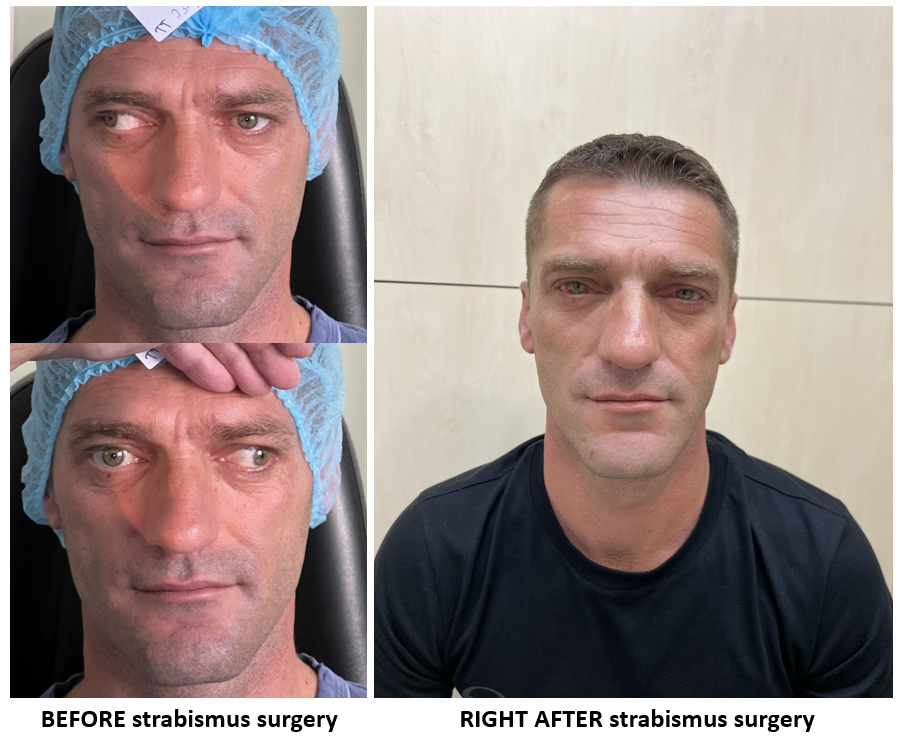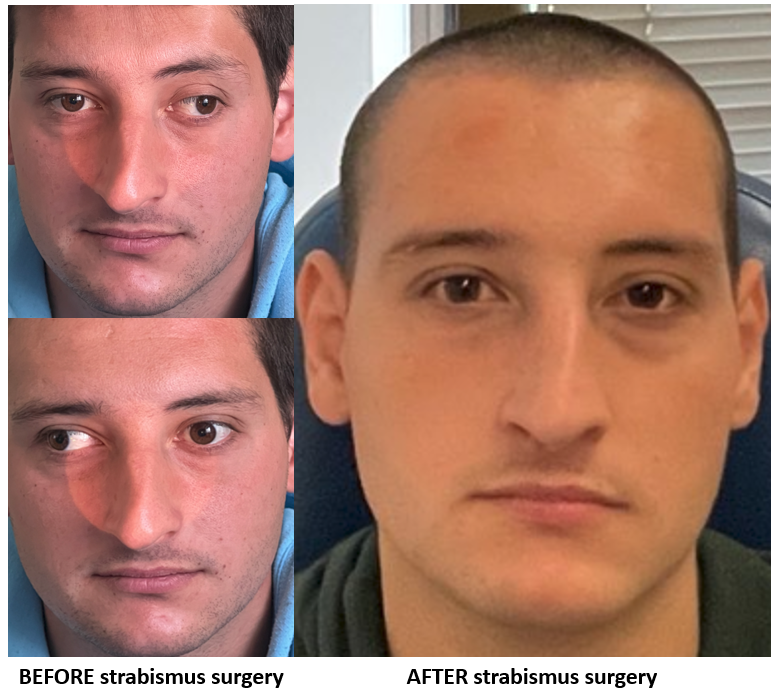
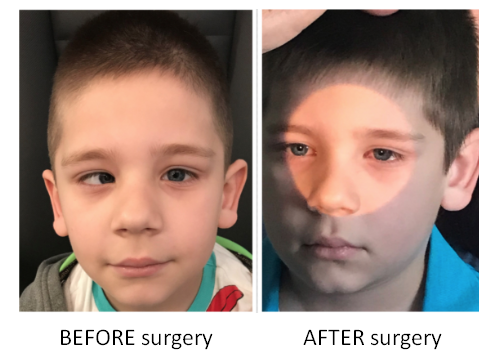

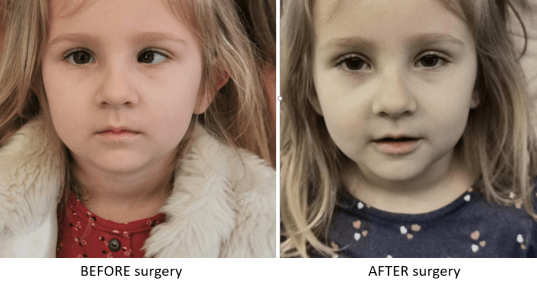
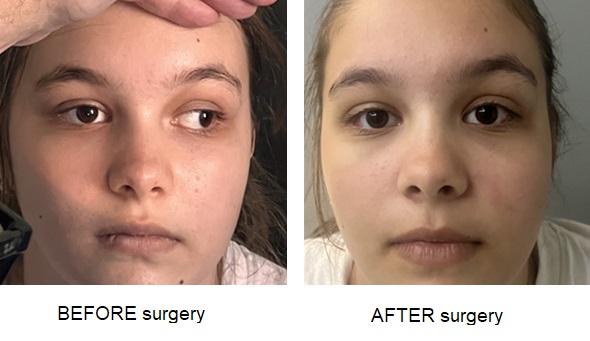
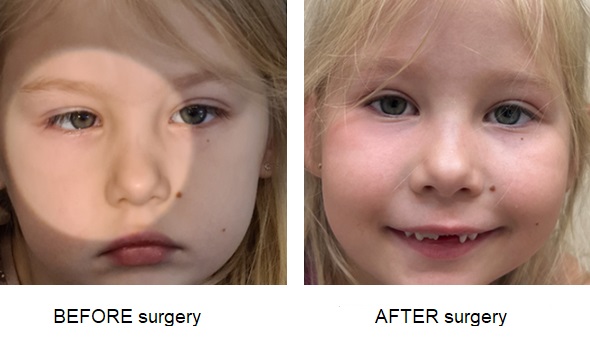
This type of surgery is performed by one of the world’s best surgeons – Prof. dr Rudolf Autrata , who is the director of one of largest pediatric ophthalmology hospitals in Europe, leading pediatric department in SVETI VID as well, and he is performing all pediatric surgeries.
He has received 6 greatest European awards for his outstanding work, in Barcelona 2008, Rome 2005, Paris 2004 and in Belgrade in 2018. Over 25 years of surgical experience is the best guarantee that patient will be operated successfully.
STRABISMUS (crossed-eyes) presents an anomaly of position of the eyes and binocular vision, as a matter of fact it is motoric and sensory anomaly. That means inability of simultaneous focusing of both eyes, actually visual axes toward the point that is fixated and forming of integrated image by viewing it with both eyes.
STRABISMUS (crossed-eyes) presents an anomaly of position of the eyes and binocular vision, as a matter of fact it is motoric and sensory anomaly. That means inability of simultaneous focusing of both eyes, actually visual axes toward the point that is fixated and forming of integrated image by viewing it with both eyes.
Orthophoria is term for normal position of eyes. Heterophoria (latent strabismus) is term for slight irregularity in visual axes position, which by fusion achieve close to parallel position. The anomaly can be diagnosed by several tests. Heterotropia is term for manifesting, clearly seen strabismus. There are several types of strabismus: congenital, acquired, with turning inward or outward, up or down, only in one eye (monocular) or alternating (eyes alternate in deviation and fixatStrabizam kod odraslihion), with following of the healthy eye or remaining in the same position etc.
Strabismus is frequent phenomenon (4 – 8 percent of population), half that group are amblyopic. It will occur at any age, most frequent in preschool age. Amblyopia (lazy eye) follows strabismus and almost every other patient with strabismus will have it. It is amblyopia, precisely inability of achieving clear, sharp image regardless what is given dioptric correction. Often the cause for this is omitted timely correction or inadequately prescribed or difficulty to correct because of great difference in diopters between eyes (anisometropia), which by standard aids, glasses or contacts is difficult to tolerate. In battle with amblyopia it is insisted on adequate correction of refractive error, and with anisometropia present, the method of choice is one of refractive procedures -excimer laser or other.
Certainly, neither laser nor any other procedure cannot “construct” sight, only correct the dioptric error, and if the visual potential is preserved, amblyopia can be partially improved. Amblyopia (lazy eye) and strabismus present great problem, for individual as much as for society (limitations in choosing profession, danger of hurting because of not seeing well etc). For formation of normal binocular vision the image that is generated in corresponding points of retina must be sharp. That sharp image in childhood is a condition for normal development of visual function.
Binocular vision is formed at about three months of age. For that normal shape and position is needed, as well as healthy refractive apparatus, meaning the eye without refractive error, with preserved anatomy and function muscles that are moving the eye, healthy neurological system and preserved nerve function in particular nerves innervating eye muscles and harmonizing their movement, center for sight where are received and analyzed visual stimuli arriving from both eyes and forming integrated one image.
If at any of these levels occurs defect in childhood, the formation of binocular, functional vision will be obstructed. The eye that does not fixate will “deviate”, and if happens in both eyes, the occurrence of nystagmus (fast, involuntary movements of the eyes) will happen, along with serious amblyopia. That obstacle could be also congenital cataract, glaucoma, with optic nerve damage, but ptosis with pupilar obstruction as well, and long-term therapeutic occlusions -in one word everything that obstructs flow of the light and generating the image on retina, or anything that contributes to different images formation on both retinas.
Strabismus may have onset even later in life in all conditions and diseases that are long-lasting: uncorrected refractive error, cloudy cornea, cataract, retinal and optic nerve diseases, diseases of nervous system within traumas or illnesses, as well as psychic trauma without visible organic cause etc. In children most often is the cause is converging strabismus (eye toward nose), and in adults it is diverging (eye outward).
Prevention of amblyopia and strabismus is manageable by timely assessment and correction of refractive error namely (hyperopia, astigmatism, myopia), then specific exercises and supervised occlusion (covering) of better eye to enforce “the lazy eye”. Not long after these exercises, the following procedure is surgical correction of strabismus to lessen or eliminate basic deviation that is remaining after the exercises. If the cause of amblyopia and strabismus is an obstacle blocking the visual axis (ptosis, cataract), first step is to “relieve” visual axis, therefore ptosis or cataract surgery, and then strabismus surgery. In children, early cataract surgery with intraocular lens implantation correcting the refractive error is one of most significant conditions in managing amblyopia and strabismus.
It was shown that the cataract surgery with simultaneous intraocular lens implantation gives better correction than aphakic correction with glasses or contact lenses and by that the degree of amblyopia is lessened. When the visual axis is freed by cataract surgery and with implant solving refractive problem, consequently program of exercises and occlusive treatment continues. It is important to follow the correction changes in pediatric patients, which by any means is not huge as in case of aphakia, but consistent with normal physiological growth of the eye.
This is a wise way of preventing strabismus, and in case it exists after the cataract operation, surgical treatment is carried out. In case of early onset of strabismus until the age of 6 months, early surgery is planned, at the latest by the age of two. If it occurs between the ages two till six, it is insisted on good correction of refractive error (hypermetropia, astigmatism) and then surgically manage remaining deviation. In later years of life when high degree of amblyopia is present, surgical treatment has more esthetic rather than functional meaning. Binocular vision, by that time had been already lost. In case of paralytic strabismus, surgical ratio is to position the eye so that double images will be eliminated. Strabismus surgery has objective to bring the eye in the right position by adjusting muscle attachments. Surgery is performed in general anesthesia, without staying in the hospital. Surgical approach, as well as anesthesiologic comfort are adapted to conditions of shorter hospitalization and faster recovery.
In Special hospital SVETI VID, problem of strabismus and amblyopia is viewed comprehensively, by board approach, team of experts in the field of refractive and cataract surgery, strabismus surgery along with neurological council. Here in one place there are ideal opportunities for cataract surgery with solving refractive problems respectively as well as laser correction of dioptric error by which a part of strabismus angle is decreased, and in some cases even resolved only by correcting refractive error. Additional strabismus surgery definitely brings the eye into normal, or closest to normal position.
STRABISMUS (CROSSED EYES) often is easy noticeable in children. Essential condition for visual function development is parallel position of the eyes. Different deviations, namely turning of the eye, or visual axis is called strabismus. In the growth period until three years of age, interval between onset of strabismus and treating it is key factor for prognosis. Early strabismus surgery means better prognosis for better quality of binocular vision achievement. Where needed, after the surgery it is continued with wearing correction or laser diopter correction (in special indications) and by amblyopia treatment by covering better eye, or alternately.
Strabismus can be classified into several subdivisions, most frequently by the direction of turning: horizontal (eso-convergent and exo-convergent, vertical, and torsional. Then concomitant (in all looking directions the angle of deviation is the same) and incomitant (different angle of deviation), usually tied to paralytic, restrictive or special syndromes (Duane, Moebius etc.).
Specific category of strabismus is ACOMMODATIVE, which is corrected by adequate correction, meaning that while wearing correction children have correct position of the eyes, but without glasses they deviate. Laser correction in these situations enables constant well corrected image, therefore the problem of strabismus is solved as well.
